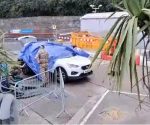The Midsomer Murder solved? Part Two: perpetrator indicates a conspiracy, police not interested
When the Valerie Graves murder case was first addressed here at FBEL in 2015, it was stated of the parameters for a DNA dragnet search operation, performed by police and intended to find the perpetrator of the crime, that they were “so random that there is a very high chance, if not a 100% probability, that they will fail to identify the murderer.” It was also stated that the operation was fundamentally flawed because “the police appear to be following an erroneous line of investigation” – which was one shaped around the notion that Valerie Graves had been killed by a burglar.
Now, if the reader has digested the initial article of this current series – which followed the conviction of a man, for Graves’ killing, in November at Lewes Crown Court – it may seem that while the author appears to have been correct in the first of his 2015 conclusions, he was not correct in his second: for the perpetrator has been revealed to be a burglar. However, things are not so clear cut. It turns out that the culprit was very much an insider (of sorts), who didn’t need to break into the property, and certainly didn’t do any burglarising. In fact, understanding him to be a burglar depends on whether or not one agrees to a consensus about it created by police and the justice system, rather than establishing it from the facts of the case. Above all else, that his being found to be a burglar justifies the police’s entirely dubious behaviour in the name of investigating his supposed ultimate crime is cause aplenty to be doubtful of the truth of it.
There is one fact upon which all other information can be built: the Surrey and Sussex police used the Valerie Graves murder investigation as a pretext for operations on the public that would not have otherwise been tolerated. There is no getting around this. To conduct a DNA dragnet search, police had to sell the idea that the local population was harbouring a suspect who carried out a burglary-gone-wrong at a property in the village of Bosham. And in this scenario, the motivation to kill had to arise during the process of a burglary, because the local community would not have known Graves from Adam: she was a holiday visitor to the village. She hadn’t even lived long in the general area, having moved (so it is said) very recently from Scotland to live on the next peninsula eastward along the coast. No one in Bosham and its immediate environs would have been interested in deliberately killing Valerie Graves.
The problem for the police was how some very crucial evidence suggested that, indeed, there had not been a burglary: there was no apparent forced entry into the property where Graves had been sleeping in a downstairs bedroom. So, the police were walking a thin line between presenting the investigation as justification for their DNA dragnet search, and appearing to be responsive to actual data that formed the experience of too many witnesses to it. We can suppose this is why police were actually cagey about declaring that a burglary had even taken place. At FBEL, it was supposed that the police would not definitively say there was a burglary expressly because there had not been one. Unsurprisingly, then, in the initial stages of the investigation the theory of a burglary was treated as being one line of enquiry amongst others – although it was obviously the one that the public was invited to see as generating police activity. Indeed, the burglary scenario was implied as being of most interest to police when there was a discovery of a discarded hammer, and it was inexplicably declared to be the murder weapon. Arguably, a hammer is a tool more useful for breaking in to a property than it is for committing murder – which would have become its secondary purpose when the intruder had been disturbed by Graves.
After the discovery of the hammer, there was the hasty follow-up and somewhat erratic arrest of a local man who lived near the spot where the implement had been found. Naturally, this completed the impression that police wanted to make; i.e. a local had burglarised the property. After the headlines had been created, it didn’t matter that Daniel Pereira had to be released as an innocent. That this was so obviously an operation to manipulate public perception is cause to entertain the distinct possibility that the hammer was planted in the location expressly to be discovered – and there might be more about this in the series still to come.
In 2019, five years after the production of a bogus suspect, and when the man who Surrey and Sussex police finally settled on processing towards a conviction for the murder of Valerie Graves turned up without any real effort on the part of plod, there were some things said publically that in fact were devastating for the burglary premise. It turns out that, while perhaps not known personally to Graves – although there is no way of knowing if this is actually true – the culprit must have been known, at least indirectly (for reasons about to be divulged), to the owner of the house in which Graves was holidaying. It is quite clear to the author that if the police had followed a line of enquiry based on this information, and asked a few simple questions along a chain of folk familiar to one another, it could feasibly have led them to the person that they say committed the crime. Quite simply, they did not do this – not publically at least – and they didn’t do it because it would have undermined the case for the DNA dragnet search.
Indeed, the revelation of the identity of the supposed murderer of Valerie Graves only produced definitive proof that the DNA dragnet search was redundant. The culprit, as was predicted at FBEL, did not fit into any of the police’s catchment definitions, which were fundamentally flawed because they discounted i) people who moved out of the area after December 2013, and ii) people beyond a range circumscribed by a seemingly arbitrary geographical boundary. It appears that the person who has been convicted of the murder of Graves was beyond police interest on both counts – but even without this hindsight, the problems were self-evident: someone could have committed the crime, and then fled the area, or someone could have lived just on the other side of the boundary line, and travelled in to commit the murder. Again, police were not interested in these possibilities because the focus, for the purpose of the creation of a consensual DNA database, had to be on contemporarily resident locals.
The man who Surrey and Sussex police say killed Valerie Graves was a man who wasn’t local to the area; in fact he was a Romanian immigrant by the name of Sabou. He lived in a caravan in a scrap yard on an industrial site where he worked – in the general Chichester area, though where this was has never been stated unambiguously in the corporate media. In other words, it is not established that i) he lived within the boundaries of the search dragnet, or, ii) he continued to live in the same area after the date of the murder.
Moreover, there is no data that puts Sabou in Bosham or Fishbourne – the two villages within the DNA dragnet zone. The author, who lives locally, is not aware of any scrap yard in any industrial estate in, or between these villages. While Sabou’s place of residence was said to be near to the A27, which clips both of these places as it arrives into Chichester, the road also continues on the other side of the city, where there are indeed scrap yards.
If corporate-media is to be believed, we know that Sabou was in Romania in October 2018, because this is when Surrey and Sussex police started having an interest in him, supposedly on the instigation of a tip-off that emanated from abroad (more about that in the next article in the series). According to a Romanian lawyer who spoke for Sabou at the hearing after his arrest in July 2019 in his native land, Sabou lived in Britain until 2018. Where exactly he lived for the duration is not at all clear. One source – the Brighton Argus (a newspaper sort of local to Lewes) – says that he fled the area two weeks after the murder. Another corporate-media outlet says that he continued to live “near Bosham” for five years, before moving to Croydon and then to Bognor Regis. That this appears to be according to Sabou’s Romanian lawyer, who presumably was working to portray him as the innocent who does not flee, might account for why his stay in two other places was squeezed into what may be an implausibly short amount of time. More likely, perhaps, the move to the much busier Croydon was indeed quite soon after the murder, and for the purpose of laying low. Be that as it may, what we can say is that there is no consistent evidence that Sabou lived in the dragnet search zone at the time police were conducting its “DNA harvest”. He may indeed have worked “close to the house in Bosham” at the time of the murder, but of course, he evidently did not volunteer to have his DNA sampled.
In fact, Sabou’s work is the primary aspect of his profile by which he has been condemned (the DNA was not even secondary, as we shall discover). Though Sabou was a scrap yard worker, he carried out “work” at the property where Graves was killed. As such, if we were wondering if this enabled us to presume that the property owner was in possession of knowledge of Sabou, another piece of corporate-media reportage perhaps provides a qualification: when Sabou went to do the work at the property, he did so accompanying a friend. There may have been even greater degrees of separation between the owner of the property and the Romanian, because the owner may well have employed an agent to maintain the house. However, whatever the dynamic, whether the owner “knew” Sabou indirectly through his friend or another party, or whether he knew him directly, it is indeed clear to the author that there was a chain of connection that started with the house owner and that should have been discoverable by police through questioning.
And yet, apparently, police did not investigate this properly, or else we should perhaps be hearing about people being in trouble for obstructing or perverting the course of justice. Moreover, Sabou’s defence lawyer at that aforementioned hearing in Romania implied that Sabou was a tax payer all the time he resided in England. This means that if his name had come up in enquiries in Bosham, and if he had moved away, there was visibility about where he could be found. Unless, of course, it’s not true that Sabou paid taxes – but then, we are not hearing about his scrap yard employer, nor whoever employed him for “work at the house” being in trouble for making cash-in-hand tax payments.
The question that begs answering is why did police, when it was entirely accomplishable, not want to discover Sabou’s identity at the outset of their investigation? The constant answer, of course, is that it would negate the need for the DNA dragnet search – which has now been firmly established as never being capable of catching Sabou. Another answer to the same question is that the chain of acquaintances between Sabou and whoever organised work on the house is something that must not attract too much scrutiny in order to protect the link in it that appears to be crucially significant in respect of Sabou’s encounter with Graves.
If it appears to the reader that, in the final sentence of the previous paragraph, there is an accusation of conspiracy which the police were not interested in uncovering, then he has not misread. The issue is inherently related to the distinct possibility introduced pretty much upon this article’s opening: Sabou was not necessarily a burglar. And the thing that the reader needs to know to arrive at this understanding is that Sabou was not convicted in a trial; instead he pleaded guilty to murder. While there was some kind of process at Lewes Crown Court, in November 2019, where the story of his guilt was explained by a prosecution lawyer – for no other reason, it seems, than that it was felt necessary to do it in lieu of the information that would have come out during the prosecution of a case (thus to convict in the court of public opinion) – essentially his conviction depended on his own admission (as shall be demonstrated in the next article in this series).
In actual fact, the apparent certainty of his guilt was established long before the Lewes court proceedings when Sabou appeared at that aforementioned hearing in Romania. He appeared to admit the crime of murder, although he said he didn’t mean it to happen:
She woke up, I panicked. I never meant to kill anybody. I am really sorry… I never meant to kill anybody. I want my wife to know what happened. It was an accident, I thought everybody was away.
The Mirror was also in possession of footage of Sabou’s arrest; in an entirely convenient development that maybe too good to be true, this film “emerged” a day before his Romanian court appearance. In it, Sabou “is seen handcuffed outside his flat in Dej, about an hour from Cluj.”
The piece goes on:
And he can be heard saying to police: “I tell you honestly I did not mean to hurt her. It was an accident.
“Somebody asked me to get into the house. It was about money.”
While this material must work perfectly for anyone desirous of Sabou that he freely incriminate himself, it also presents a problem for the narrative which would otherwise hide a dead hand behind the crime. Sabou has here indicated that his visit to the house in which Graves was staying was not automatically motivated by any money he could steal from Graves or other persons who were holidaying there (note that he says that he did not expect people to be in the house). Most significantly, Sabou clearly says that he was acting in response to a request – so it could be construed that he was sent to the property, and paid to do it.
It would follow, then, that whatever possible scenario could explain the reason for Sabou being at the property, it would always involve him being sent: and this constant would answer the question raised in the first in this series of articles as to why Sabou would proceed with his plan upon finding an unlocked door indicating the property was not empty as he had been led to believe? He was not disconcerted, because he has been told to expect it.
So, on face value, and in the officially promoted scenario, Sabou is at the property to burglarise it – but what happens? He becomes incriminated in a murder – and we must then hypothesise that this is the actual point of his being sent there. We don’t know if Sabou is degenerate enough to intend to kill Graves, or if he merely did cause her death accidently, but if anyone expected the outcome of murder to be produced in a disturbed-burglary scenario, they must have known how Sabou would react when he found himself in it. It follows that if it was known that Sabou would not intentionally kill, then he was at the property purely to incriminate himself, whether he was burglarising or not. And he certainly does not appear capable of being the complete brute – not if he was surprised to later discover that he did anything in the process or avoiding discovery and fleeing that was enough to kill a person. So, to ensure the outcome of murder, someone else would have had to be along later to murder Graves – or even precede Sabou’s visit, and then make him think he had had an encounter with Graves after she had been disturbed by his presence.
But what if Sabou is lying? On gut reaction, one could say that if Sabou is not telling the truth about any part of his story, then the lies would most likely be intended to mitigate his guilt: and so he would say that he didn’t mean to kill Graves, and he would imply that the responsibility for her death was not all his own. However, if he is not lying, or even if he is only partially dissembling, then there would be scope for police to be compelled to look into the possibility of a conspiracy to murder, and to look beyond Sabou as the killer – and yet police are not interested. Why not? Well, letting them off the hook somewhat is how the case is well and truly closed, with the Lewes court proceedings providing the moment when Graves’ murder passed into official history via the judge’s summing up, interestingly conveyed to the Chichester local paper via a police spokesman:
Judge Christine Laing said: “It was your dishonesty which led you to carry out the burglary and it was your lack of conscience which led you to kill Valerie.
“I accept that you did not go there to kill or harm, your motivation was greed.”
Of course, this is astonishing stuff, and in a proper country it couldn’t possibly provide judicial closure. The author would humbly suggest that if the judge accepted that Sabou did not mean to kill Graves, then a trial should have been had to discover what interaction Sabou had had with her, and why exactly Sabou appears not to understand how she was killed at his own hands, and ultimately to provide an opportunity for a jury to find Sabou guilty of manslaughter, but not murder. Blaming the failure to do this on whatever sorry example of a defence counsel Sabou had is completely unsatisfactory. Instead, it begins to look like Sabou was subjected to a showtrial to suit public expectations created by police who declared Graves to have been murdered by a burglar – which was necessary, returning to where we came in, in order to justify the DNA dragnet search. Crucially, there was no attempt to entertain the prospect of an accidental death without malice aforethought: the definition of manslaughter. In other words, and it wouldn’t be the first time, the Establishment was in cahoots with itself on a psychological operation.


















